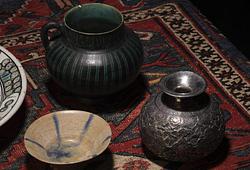Chinese Imari ’Dame au Parasol’ plate decorated in underglaze blue, iron-red and gilt, Qing dynasty, Qianlong 1730-40.
After a design by Cornelis Pronk, painted in the center with a scene of an oriental lady walking shaded by a parasol being held by her attendant walking behind her, the lady is gesturing to four waterfowl standing by a grassy bank, the background with reeds and aquatic vegetation, all within a narrow band of rosettes and flower-sprays at the well, the border with figural and bird cartouches on a honey-comb pattern ground, the reverse with seven flying insects in underglaze blue. Diameter: 23.2 cm.
Damaged, restored.
Provenance
Cornelis Pronk (1691-1759) the artist responsible for this design, was born in Amsterdam in 1691. He was commissioned by the Dutch East India Company (VOC) in 1734 to design drawings for Chinese porcelain. Pronk made four series of drawings over three and a half years. It is likely that the ‘Dame au Parasol’ drawing was the first, having been sent to China and Japan in 1736. Only this design is known in both China and Japan. The porcelain was made in Jingdezhen in southern China, the designs ordered in blue and white, coloured enamels and coloured and gold interpreted as Chinese Imari (blue, iron-red and gold). The first group of such decorated porcelain was sent back to Holland on the “Magdalena” in 1737.
The “parasol” design was an instant success, but the high cost of production proved to be prohibitive, and further orders were not placed anymore.
Original drawings for the designs can be found at the Rijksmuseum in Amsterdam.
Literature
See ”Chinese Ceramics in the Rijksmuseum Amsterdam”, C. Jörg, p. 282 for a discussion on Pronk designs.






























